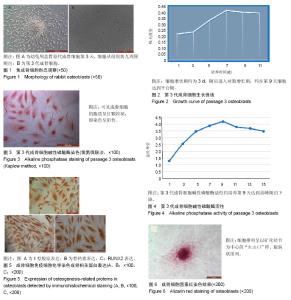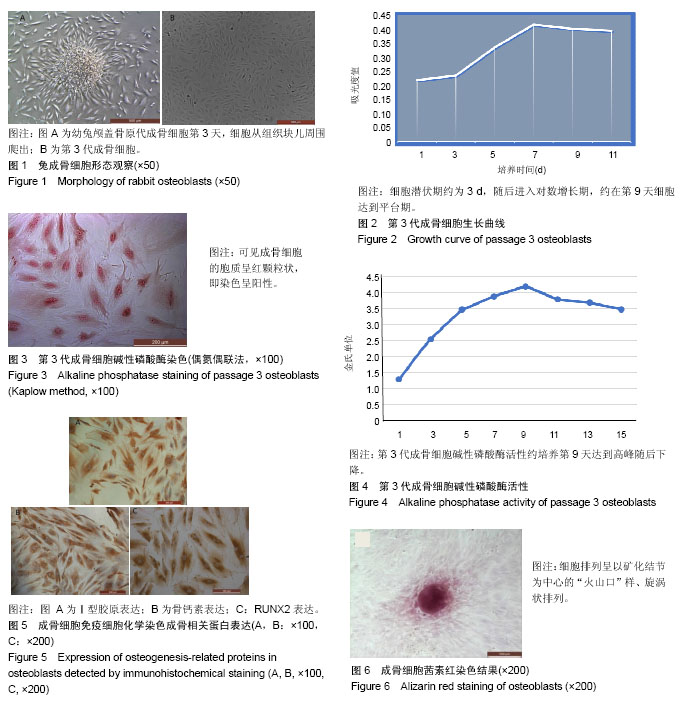| [1] Mills BG,Singer FR,Weiner LP, et al.Long-term culture of cellsfrom bone affected by Paget's disease. Calcif Tissue Int. 1979;29(2):79-87.[2] 王勇平,廖燚,蒋垚.成骨细胞的体外培养与鉴定[J].中国组织工程研究,2011,15(33):6231-6234.[3] Kreider BQ,Messing A,Doan H,et al.Enrichment of Schwann cell cultures from neonatal rat sciatic nerve by differential adhesion. Brain Res. 1981;207(2):433-444.[4] 张晓娟,段梦园,李娟,等.小鼠颌下腺上皮细胞的体外培养及鉴定[J].基础医学与临床, 2018,38(2):229-232. [5] Iwasaki M,Kuroda J,Kawakami K,et al.Epidermal regulation of bone morphogenesis through the development and regeneration of osteoblasts in the zebrafish scale. Dev Biol. 2018;437(2):105-119.[6] Kim M,Yu Y,Moon JH,et al.Differential Expression Profiling of Long Noncoding RNA and mRNA during Osteoblast Differentiation in Mouse. Int J Genomics. 2018;2018:7691794.[7] Kalajzic I,Matthews BG,Torreggiani E,et al.In vitro and in vivo approaches to study osteocyte biology.Bone.2013;54(2): 296-306.[8] Shah KM,Stern MM,Stern AR,et al.Osteocyte isolation and culture methods. Bonekey Rep. 2016;5:838.[9] 马蓉,王艳梅,庄友梅,等.兔牙髓细胞的体外增殖及鉴定[J].中国组织工程研究, 2012, 16(49):9236-9240.[10] Dominici M,Le Blanc K,Mueller I,et al. Minimal criteria for defining multipotent mesenchymal stromal cells.The International Society for Cellular Therapy position statement. Cytotherapy.2006;8(4): 315-317.[11] Roeder E,Matthews BG, Kalajzic I.Visual reporters for study of the osteoblast lineage.Bone.2016; 92:189.[12] Zhu H,Kimura T,Swami S,et al.Pluripotent stem cells as a source of osteoblasts for bone tissue regeneration. Biomaterials. 2018 Feb 5. pii: S0142-9612(18)30080-2.[13] Komori T.Runx2, an inducer of osteoblast and chondrocyte differentiation. Histochem Cell Biol. 2018;149(4):313-323.[14] Liu G,Hu YY,Zhao JN,et al.Effect of type I collagen on theadhesion ,proliferation ,and osteoblastic gene expression of bone marrow-derived mesenchymal stem cells.Chin JTraumatol. 2004;7(6):358-362.[15] 杨森,冯付明,王银辉.乳兔成骨细胞原代培养与鉴定:改良胶原酶与胰酶的分段消化[J].中国组织工程研究,2014,18(38): 6129-6135.[16] Hasegawa Y,Shimada K,Suzuki N,et al.The in vitro osteogenetic characteristics of primary osteoblastic cells from a rabbit calvarium. J Oral Sci. 2008;50(4):427-234.[17] Yu J,Xu L,Kai L, et al.Zinc-modified Calcium Silicate Coatings Promote Osteogenic Differentiation through TGF-β/Smad Pathway and Osseointegration in Osteopenic Rabbits. Sci Rep. 2017;7(1):3440. [18] Hasegawa T. Ultrastructure and biological function of matrix vesicles in bone mineralization. Histochem Cell Biol. 2018; 149(4):289-304.[19] Wang YL, Hong A, Yen TH, et al.Isolation of Mesenchymal Stem Cells from Human Alveolar Periosteum and Effects of Vitamin D on Osteogenic Activity of Periosteum-derived Cells.J Vis Exp. 2018 May 4;(135). doi: 10.3791/57166.[20] Maruyama Z,Yoshida CA,Furuichi T,et al.Runx2 determines bone maturity and turnover rate in postnatal bone development and is involved in bone loss in estrogen deficiency. Dev Dyn. 2007;236(7):1876-1890.[21] Komori T.Roles of Runx2 in Skeletal Development.Oxygen Transport to Tissue XXXIII.2017;962:83-93. |

